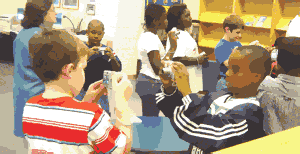 I have been involved in educational technology since 1981. The years have been characterized by long steady periods of learning and development. These times have been like riding a long a plateau with little significant change. However, these years have been accented by dramatic lunges upward, as a discover something new that so thrills my sense of the possiblities that it is like being violently lifted to a new plateau. Here are some of the discoveries that Have caused these lunges upward:
I have been involved in educational technology since 1981. The years have been characterized by long steady periods of learning and development. These times have been like riding a long a plateau with little significant change. However, these years have been accented by dramatic lunges upward, as a discover something new that so thrills my sense of the possiblities that it is like being violently lifted to a new plateau. Here are some of the discoveries that Have caused these lunges upward:
- 1981 – BASIC (Programming the computer, using incantations that enchant these machines to be or pretend to be almost anything)
- 1987 – FrEdMail (Using e-mail and discovering that classroom walls may become transparent)
- 1990 – Hypertalk (another programming language and even more magic)
- 1993 – HTML (publishing information to a growing global audience and linking my information to a global web of content)
- 1997 – PHP & MySQL (Applying the magic to the web: Citation Machine, PiNet, etc.)
Each upward lunge lasted a couple of weeks as I discovered a new technology and its potential, and began to grapple with new technical skills. Then things leveled off as I became accustomed to a new altitude.
During this last year, it happened again. A steep incline began in late December of 2004, and it simply has not stopped. I had decided to devote two weeks to reading the weblogs of a number of educators I had come to respect, and the result has been an entire year that was a stunning dash up an amazingly steep hill of new ideas; new technologies; new ways of thinking about what I do, how, and why I do it; and of new possibilities for helping teachers and students.
What’s new is that these discoveries, by their own nature, caused a breathtaking loop of new discoveries, each leading to something else, just as dramatic. It began with Blogging, which I had been doing for nearly a year. However, when I started reading the blog postings of other educators, and learned to subscribe to their writings with aggregators, I began to understand the importance of XML and to explore RSS. I started to integrate these technologies into my web services and staff development and to form, what I now call, a Personal Learning Network of people who have something to say that helps me do my job.
Then came podcasting and new ways to apply what I was learning about RSS. My personal learning network expanded to forward-thinking people, many of them the inventors of these new technologies, who were reflecting on the potentials of this emerging collaborative information environment — and I was hearing it from their own voices. I started using Technorati and Blogpulse, discovering that this expanding blogosphere can actually be a valuable source of content. I learned about and implimented Moodle and Drupal sites for managing my own content and instructional services, and learned to connect them to my grown personal network and a personal digital library of published content — del.icio.us. I used Skype to hold interviews with people and to collaborate in creating multimedia information products. This last Monday, I had a practice session for an upcoming Kansas conference presentation that I will deliver from the comfort of my office, through my laptop and iSight camera.
I could go on and on. But it is important to note that there are two underlying concepts that thread through all of these discoveries.
- They are all connected together in ways that were foreign to me twelve months ago, and
- they are all about learning.
My philosophy of education has been rocked this year, and it still has not settled down. It is with some anxiety but even more anticipation that I face a new year.
I want to close this out with a list of people, whom I would like to publicly thank for being a part of my learning network, and for making this the most exciting professional year of my life.
I know that I’ll leave some names out, but as they occur to me, I’ll add them in.
|
John Beck John Blake Joe Brennan Tony Brewer Jay Bryant Andy Carvin Dave Cormier Karen Creech Hall Davidson Steve Dembo Tim DiScipio Acacia Dixon Steven Downes Terry Freedman Thomas Friedman Janice Friesen Wesley Fryer |
Miguel Gulin Tom Hoffman Rem Jackson David Jakes Doug Johnson Ian Jukes Doug Kaye Vinod Khosla Eric Langhorst Jeff Lebow Chris Lehmann Lawrence Lessig Gail Lovely Jeff Moore Nick Noakes Marco Polo Bernajean Porter |
John Raymond Will Richardson Brian Russell Donna Sawyer Robert Sawyer Kathy Schrock Tom Sheehan George Siemens Chris Smith Bob Sprankle Meg Turner Jeff Utecht Tony Vincent Jennifer Wagner David Weinberger Tim Wilson |
I also thank every audience I have worked with and event facilitator who has brought me in. All have helped me to refine what I do. I’ve never been happier professionally.

 I just posted my
I just posted my  I’ve been working on a reflective article for a number of days now, in amongst the holiday activities, but ran across this from Web Usability Guru
I’ve been working on a reflective article for a number of days now, in amongst the holiday activities, but ran across this from Web Usability Guru  It seems to me that in order to shape the application of new technologies, we need a mold to shape it around, and that mold needs to be new as well. One of our problems has been that we have tried to shape the technology around out-dated notions of what schooling is about, rather than reshaping our notions to reflect new world conditions.
It seems to me that in order to shape the application of new technologies, we need a mold to shape it around, and that mold needs to be new as well. One of our problems has been that we have tried to shape the technology around out-dated notions of what schooling is about, rather than reshaping our notions to reflect new world conditions.  I have talked lately, at a number of events, about
I have talked lately, at a number of events, about  Now on to my wish list. Here are three things that I want — beyond world peace. I want:
Now on to my wish list. Here are three things that I want — beyond world peace. I want: